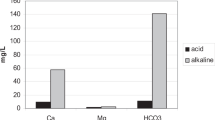Abstract
Hot dry winds (Sharav in Israel) are notorious for causing controversial symptoms such as depression, discomfort, headaches, irritability and exacerbation of respiratory ailments. Daily urinalysis combined with study of the complaints of two hundred weather-sensitive patients suffering from Sharav have shown that there exist at least three different patterns of reaction: serotonin hypersecretion causing a general "Irritation Syndrome", catecholamine deficiency resulting in the "Exhaustion Syndrome", histamine and creatinine overproduction combined with clinical "Hyperthyroidism - Forme Fruste" and typical thyroid complaints. These syndromes are amenable to appropriate treatment controlled by urinalysis.
Zusammenfassung
Trockene heisse Wüstenwinde (Sharav in Israel) rufen eine seltsame Mischung von Symptomen hervor wie Depression, Unwohlsein, Kopfschmerzen, Reizbarkeit und Verschlimmerung respiratorischer Beschwerden. Tägliche Urinuntersuchungen kombiniert mit dem Studium der verschiedenen Beschwerden von 200 Sharav-gefühligen Personen haben gezeigt, dass drei verschiedene Reaktionsformen vorliegen: Serotonin-Ausschüttung, die zu einem allgemeinen Irritationssyndrom führt; Katecholamin-Mangel, der zu einem typischen Erschöpfungssyndrom führt; Histamin- und Kreatinin-Ausschüttung, die mit leichtem Hyperthyreoidismus einhergehen. Letzteres Syndrom bereitet dem Patienten nur an Sharav-Tagen Beschwerden. Die Syndrome sind durch gezielte und Urin-kontrollierte Behandlung heilbar.
Resume
Des vents chauds et secs provenant du désert (le Charav en Israël par exemple) sont connus pour provoquer un ensemble de symptômes particuliers tels que dépression nerveuse, indisposition, céphalées, irritabilité et aggravation des troubles respiratoires. L'analyse journalière de l'urine et l'étude des divers symptômes que présentaient 200 personnes sensibles au Charav ont montré la présence de trois formes différentes de réactions: sécrétion accrue de sérotonine qui conduit à un syndrome d'irritabilité générale; une carence en catécholamine qui se traduit par un syndrome typique d'épuisement; une sécrétion d'histamine et de créatinine parallèle à un faible hyperthyréoïdisme. Ce dernier syndrome ne provoque des troubles aux patients que durant les jours où le Charav souffle. Ces trois syndromes sont guérissables par une médication appropriée et dont l'effet est contrôlé par des analyses d'urine.
Similar content being viewed by others
References
BASS, D.E. and HENSCHEL, A. (1956): Responses of body fluid compartments to heat and cold. Physiol.Rev., 36: 128–144.
BASS, D.E., KLEEMAN, C.E., QUINN, M., HENSCHEL, A. and HEGNAUER, A.H. (1955): Mechanisms of acclimatization to heat in man. Medicine (Baltimore), 34: 323–380.
BURCH, C.E. and DePASQUALE, N.P. (1962): Hot Climates, Man and his Heart. Charles C. Thomas, Springfield, Ill.
COLLINS, K.J. and WEINER, J.S. (1968): Endocrinological aspects of exposure to high environmental temperatures. Physiol.Rev., 48: 785–839.
CONN, J.W., JOHNSTON, M.W. and LOUIS, L.H. (1946): Acclimatization to humid heat: a function of adrenal cortical activity. J. Clin.Invest. 25: 912–913.
FELDBERG, W. (1965): A new concept of temperature control in the hypothalamus. Proc.roy.Soc.Med., 58: 395–404.
HAMBURGER, Ch. (1954): Six years' daily 17-Ketosteroid determinations in one subject. Seasonal variations and independence of volume in urine. Acta Endocr. (Kbh.), 17: 116–127.
HELLMAN, K., COLLINS, K.J., GRAY, C.H., JONES, R.M., LUNNON, J.B. and WEINER, J.S. (1956): Excretion of urinary adrenocortical steroids during heat stress. J.Endocr., 14: 209–216.
LEE, H.K. (1965): Terrestrial animals in dry heat: Man in the desert. In: Adaptation to Environment, Handbood of Physiology, Section 4. D.D. Dill (ed.), Williams and Wilkins Baltimore, pp. 531–582.
LEITHEAD, C.S. and LIND, A.R. (1964): Heat Stress and Heat Disorders. Cassell Publ. London.
MACFARLANE, P.S., DALGLIESH, C.E., DUTTON, R.W., LENNOX, B., NYRUS, L.M. and SMITH, A.N. (1956): Endocrine aspects of argentaffinoma and 5-HIAA determinations. Scot.Med.J., 1: 148–155.
MOSHER, R.E., BOYLE, A.J., BIRD, E.J., JACOBSON, S.D., BATCHELOR, T.M., LLOYD, T.I. and GORDON, B.M. (1949): The use of flame photometer for the quantitative determination of sodium and potassium in plasma and urine. Amer.J.clin.Pathol., 19: 461–470.
OATES, J.A., MARSH, E. and SJOERDSMA, A. (1962): Studies on histamine in human urine using a fluorometric method of assay. Clin. chim. Acta, 7: 488–497.
ROBINSON, N. and DIRNFELD, F.S. (1963): The ionization state of the atmosphere as a function of the meteorological elements and of various sources of ions. Int.J.Biometeor., 6:101–110.
ROBINSON, K.W., HOWARD, D. and MACFARLANE, W.V. (1955): Observations on seasonal fluctuations in 17-Ketosteroids output in the subtropics and tropics. Med.J.Austr., 2: 756–759.
SCHAEPDRYVER, A.F. de (1958): Differential fluorometric estimation of adrenaline and noradrenaline in urine. Arch.int.Pharmacodyn., 115: 223–245.
STREETEM, D.H.P., CONN, J.W., LOUIS, L.H., FAJANS, S.S., SELTZER, H.S., JOHNSON, R.D., GITTLER, R.D. and DUBE, A.H. (1960): Secondary aldosteronism: metabolic and adrenocortical responses of normal men to high environmental temperatures. Metabolism, 9: 1071–1092.
SULMAN, F.G. (1954): Routine micromethod for determination of urinary 17-Ketosteroids. Acta Endocrin. (Kbh.), 15: 139–198.
SULMAN, F.G., BAR-JOSEPH, N. and HIRSCHMANN, N. (1962): Routine method for determination of urinary 17-hydroxycorticoids. Israel Med.J., 28: 220–224.
SULMAN, F.G., HIRSCHMANN, N. and PFEIFER, Y. (1964): Effect of hot, dry desert winds (Sirocco, Sharav, Hamsin) on the metabolism of hormones and minerals. Arid Zone Research (UNESCO), 24: 89–95.
TAUSSKY, H.H. (1956): A procedure increasing the specificity of the Jaffe reaction for the determination of creatine and creatinine in urine and plasma. Clin.chim.Acta, 1: 210–224.
TAYLOR, H.L., HENSCHEL, A., MICKELSON, O. and KEYS, A. (1943): The effect of sodium chloride intake on the work performance of man during exposure to dry heat and experimental heat exhaustion. Amer.J.Physiol., 140: 439–451.
UDENFRIEND, S., WEISSBACH, H. and BRODIE, B.B. (1953): Assay of serotonin and selected metabolites, enzymes and drugs. Methods of Biochemical Analysis. D. Glick (ed.), Interscience Publ. N.Y., 6: 95–130.
WATANABE, G.I. and YOSHIDA, S. (1956): Climatic effect on urinary output of neutral 17-Ketosteroids. J.app.Physiol., 9: 456–460.
Author information
Authors and Affiliations
Rights and permissions
About this article
Cite this article
Sulman, F.G., Danon, A., Pfeifer, Y. et al. Urinalysis of patients suffering from climatic heat stress (Sharav). Int J Biometeorol 14, 45–53 (1970). https://doi.org/10.1007/BF01440676
Received:
Issue Date:
DOI: https://doi.org/10.1007/BF01440676




